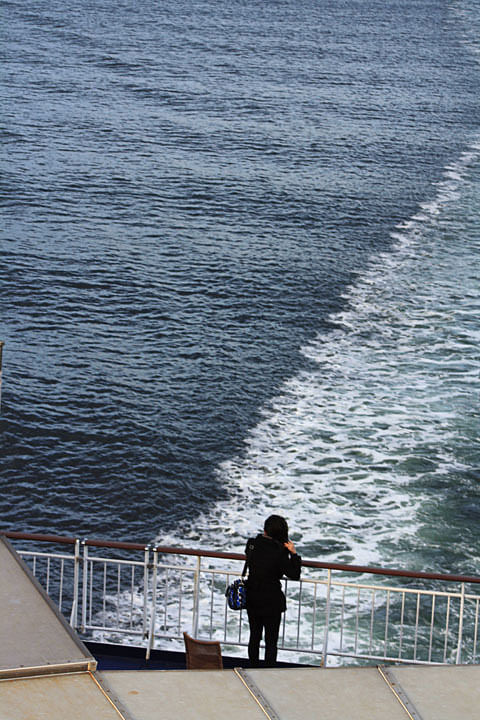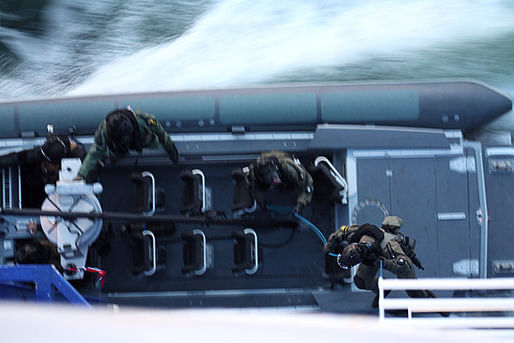
Part III of Spring Break installment
For the final leg of our adventure west of Finland, we journeyed up to Oslo, the capital city of Norway. Hopping on an overnight ferry out of Copenhagen, we cut our way up into the choppy North Sea and awoke in the early morning to watch Norwegian Fjords pass and Oslo’s harbor rise into the horizon.
 Just off the ferry: our immediate view upon arrival.
Just off the ferry: our immediate view upon arrival.
Slightly over the population of Helsinki (and slightly under the latitude), Oslo was founded nearly one thousand years ago. Indeed, the city is a blend of old and new, and what distinguishes Oslo from all the other Nordic towns we have visited thus far is the topography; its buildings and grid are comfortably nested into the surrounding hillsides that tumble down into the ocean. Though Helsinki does have significant topography, it is not as severe.
Holmenkollen Ski Jump designed by JDS Architects (Formerly PLOT with Bjarke Ingalls) It was the recipient for the Norwegian Steel Construction Prize 2011
 The hilly and upper-class Neoclassical neighborhoods of the Frogner Borough
The hilly and upper-class Neoclassical neighborhoods of the Frogner Borough

Entry Stair to the Oslo Museum of Decorative Arts; note the grade on the street
Like Copenhagen, Malmö, and Helsinki, Oslo is also undertaking a bold initiative to develop and reclaim its historically industrial waterfront. They are doing this with a mix of cultural institutions alongside progressive and aggressive waterfront housing projects. With construction cranes everywhere, this master planning is still in its infancy.
 Construction everywhere
Construction everywhere
A few projects have been completed, including the Tjuvholmen neighborhood and Snøhetta’s iconic Oslo Opera House. A new Renzo Piano museum is well underway in construction.
 Though the Opera House is enormous, it is fantastically successful in maintaining a lowprofile relative to its neighbors in the harbor and hills beyond. Above, leaving Oslo by Ferry.
Though the Opera House is enormous, it is fantastically successful in maintaining a lowprofile relative to its neighbors in the harbor and hills beyond. Above, leaving Oslo by Ferry.

 The manner in which it rises from the sea allows the building to not appear as tall as it really is. It is only once one is directly at it's foot that the enormity is grasped.
The manner in which it rises from the sea allows the building to not appear as tall as it really is. It is only once one is directly at it's foot that the enormity is grasped.
 From atop, wonderful views of the harbor and surrounding city are available. Above is the Ferry to Copenhagen.
From atop, wonderful views of the harbor and surrounding city are available. Above is the Ferry to Copenhagen.

The new public space was buzzing with use. From picnics, to photoshoots, to kids up to no good. This roofscape has clearly become an anchoring node for activity in the city.
 Interior panorama of the Opera House foyer
Interior panorama of the Opera House foyer

Wall of the coat room, designed by Icelandic Artist, Olafur Eliasson
Another noticeable aspect of Oslo was the cost of everything; it was overwhelmingly expensive. To put it into perspective, a .33L bottle of soda at a convenience store cost over 5 dollars. A value meal at McDonald’s ranged from $15 to $20. Apparently Norwegians earn about the same wages as the Danes, but they are taxed less. As a result the cost of living has risen, and it roughly evens out between the two in the end. Cost aside, there was a wealth of museums, gardens, and parks to explore, wonderful pedestrian streets, friendly people, and great architecture and public art. It was inspiring to find ourselves yet again in another country that holds good design and public space to the highest regard.
 Pritzker Prize winning Norwegian Architect Sverre Fehn' s addition to the Museum of Architecture
Pritzker Prize winning Norwegian Architect Sverre Fehn' s addition to the Museum of Architecture
 Norwegian Artist Edvard Munch's Grave - yes, we saw his "The Scream"
Norwegian Artist Edvard Munch's Grave - yes, we saw his "The Scream"

In the Frogner borough there is a wonderful place called Vigeland Sculpture Park by Gustav Vigeland. Designed with Art Deco nuances, this was a wonderful place to explore. Above, the "Monolithe" the nearly 50ft tall obelisk of figures.

Vigeland is filled with countless sculptures that tell raw figural stories of emotion, love, protection, provision, and even a few cases of abuse.
 United States Embassy, completed in 1959, designed by Finnish-American Architect Eero Saarinen. The paranoid fence has since been added.
United States Embassy, completed in 1959, designed by Finnish-American Architect Eero Saarinen. The paranoid fence has since been added.

Oslo's Fjord
Old World War II Military Base along the Fjord

Sightseeing on the Fjord One of the more exciting moments of the trip was when we noticed this skiff following our ferry for some time.
One of the more exciting moments of the trip was when we noticed this skiff following our ferry for some time.
 The skiff soon sped up and straddled alongside the rear of the cruise ferry.
The skiff soon sped up and straddled alongside the rear of the cruise ferry. Masked men then proceeded to board by a grappling hook and rope. It turns out that this was the Norwegian equivalent of the Navy SEALS, doing anti-terrorism training.
Masked men then proceeded to board by a grappling hook and rope. It turns out that this was the Norwegian equivalent of the Navy SEALS, doing anti-terrorism training. 
They have an agreement with the ferry line to practice operations once a month, unannounced. Sometimes they board by boat, sometimes by repelling from helicopters. It was impressive and fun to watch. They boarded and repelled several times before strafing off.  Norwegian Sunset.
Norwegian Sunset.

This work by A.D.Morley & J.A.Wong is licensed under a Creative Commons Attribution-NonCommercial-NoDerivs 3.0 Unported License.
A new adventure begins as we finish one chapter; we hope to share our story with you. We are graduates of Washington University in St. Louis, Sam Fox School of Design & Visual Arts.
5 Comments
Very cool! Thanks for the report.
two questions; what is the "parametricy/deconstructed) object/building in water in the foreground of the image of opera house? between the ferry and opera house?
and what is large building on cliffside in the image of the fjord?
Kind of odd that the Navy can just show up on a ferry unannounced & board it...and that that is public info. This would seem to make it far too easy for a small band of terrorists to hijack a cruise ship, somali pirate style.
Especially after last summer when a nutcase disguised himself as a cop and then wandered around a campground shooting 70+ people. You'd think the Norwegians would be a little more sensitive about this kind of thing.
Vikings be stupid, yo!
@ Nam Henderson
The object in the water between the ferry and the opera house is one of the permanent sculptures commissioned by the Opera House. The floating sculpture is entitled "She Lies" by Monica Vonvicini. Using steel and glass, it represents the delicate and powerful icebergs of the north. Fixed to a concrete platform, the sculpture rises and falls with the movement of the wind and tides to reflect the changing nature of our environment.
As for the building on the Oslo fjord cliffside, it is the Sunnaas Hospital located on the Nesodden peninsula. It was built in the 1950's by the female Norwegian architect Kirsten Sinding-Larsen. It remains the largest specialty hospital and rehabilitation center in Norway.
thanks!
Block this user
Are you sure you want to block this user and hide all related comments throughout the site?
Archinect
This is your first comment on Archinect. Your comment will be visible once approved.